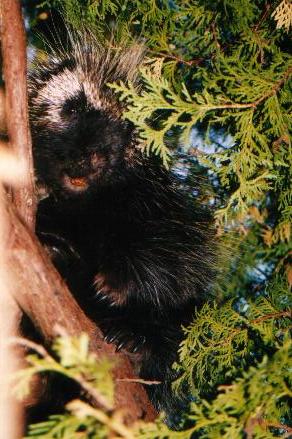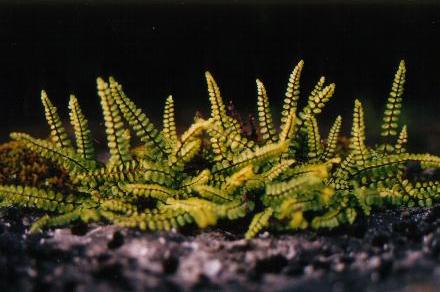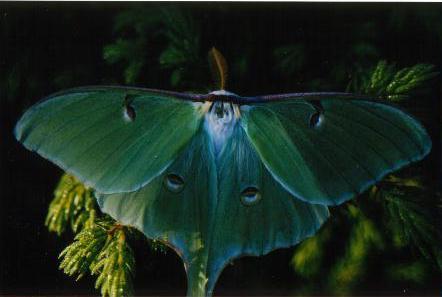

EARTHQUEST Explores the Trail |
|---|
Article and photos by Dave Jolly, EARTHQUEST (Canada) founder and Executive Director
Published in Bruce Trail News, Summer 2001 issue, pages 29-31
ďAs a Canadian non-profit organization EARTHQUEST (Canada) has been actively documenting the flora and fauna species of the Bruce Trail since 1999. To date, I have led 3 Expedition teams over a total distance of 182 kilometers - hiking 241 143 steps to complete the first leg of our 5 year plan."
The idea to fully record Bruce Trail flora and fauna came to me while camping at Mountain Trout Camp at Gillies Lake about 7 years ago. I realized that there really was not much information on flora and fauna species of the region so I endeavored to contact the BTA to find out more. To my suprise I discovered that throughout the 30 year history of the Bruce Trail and the fact that the BTA membership extended to over 10 000 people
across Ontario, some of whom were naturalists and biologists, nobody ever proposed to collect information on the natural history of the trail system. On this basis I decided to design a project specifically tailored toward that purpose.
Over a 34 day period from June, 1999 to September, 2000 EARTHQUEST teams recorded 221 vascular plants, 76 birds, 25 butterflies, 13 mammals, and 12 species of amphibians and reptiles between Tobermory and ďThe GlenĒ Management Area just north of Owen Sound. The majority of people who joined
these teams came from various academic institutions across Canada such as the McMaster University, the University of Alberta, the University of Western Ontario, Lakehead University and the University of Toronto. These individuals were selected because of their interest in the project and their keeness and
dedication to nature. During the second season of the project we received funding from Human Resource Development
Canada (HRDC) to hire individuals to work on the project.
Along the way we have met and befriended numerous people - from the friendly hikers on the trail itself to the warm and compassionate people who live and have their businesses set up along the trail path. Moreover, we have found that the common thread linking these delightful people to their way of life was the Bruce Trail itself. Like a giant rib reaching out to itís vital organs the Niagara Escarpment gave up itís beauty and natural history treasures countless times while we proceeded to work on the trail system.
Expedition #1
Yellow Wart mushroom I never knew mushrooms could be so captivating to look at until I started photographing them; their colors and
textures continue to astound me even today. As the first Expedition team moved along the rocky surface of the Bruce Trail toward Cypress Lake more amazing creatures crossed our paths. We encountered Milk Snakes, Eastern Garter Snakes, hoards of strikingly beautiful butterflies and a bounty of wildflowers. Perhaps the most significant mammal came to our attention while staying at Ann and Don Bardís Cape Chin Connection Bed & Breakfast Country Inn near Cape Chin during the night of July 24th, 1999. Ann had explained that a young Black Bear was roaming around the premises in the early hours of the day. Almost like clockwork it would arrive around 3:00 am. Not
wanting to miss out on a great opportunity to see a bear several team members and I decided to wake up at that time and listen for the bear. Bryan McLean was the first to awaken, but to the sound of a lonely Mountain Lion (or perhaps more accurately, a lone coyote ...)! Iíll never forget the excitement that prevailed the following day as we sat down to enjoy home-cooked berry pancakes, coffee, danishes and fruit salad for breakfast at Annís country retreat.
As Expedition #1 came to a close on July 29th, I began to realize just what a magical place the Bruce Peninsula
can be. There were times when I had enjoyed the mystery of nature by listening to the chirp of crickets and the calls of birds, but the Bruce somehow had a spiritual power over me. I would soon learn what that was during my second Expedition to the Bruce with another team of highly motivated individuals.
Expedition #2
Our first Milk Snake drew alot of attention as team members tried to get close enough to grab some shots. As we hiked around to the other side of the Nature Reserve, we saw our first of four sightings of porcupines.
My elusive Porcupine This was a young porcupine that quickly climbed to the top of the tree before I could capture itís image on film - truly a disappointment as I was eagerly trying to obtain a sharp image of one of these rodents for our field guide book. I had a love affair with the idea of getting a good quality shot in itís natural habitat. There would be 3 other sightings of these sluggish creatures before an opportunity would present itself.
At Cape Croker we hiked through the boardwalk and saw Showy Lady Slipper orchids and I said my good-byes to the team and prepared to tackle the task of surveying the flora and fauna from Cape Croker to Tobermory with my wife Jan later in September.
Expedition #3
I greatly enjoyed the data collection and explored every nook and cranny of the moss-covered trail as it meandered with the escarpment. I felt a very spiritual attachment to my surroundings.
Later, I found some Maidenhair Spleenwort ferns that looked like they had an attachment to the rockface of another type;
Maidenhair Sleenwort fern During the final week of field work I was joined by my wife and together we completed the last leg toward Owen Sound. At Colpoyís Bay I had missed a rare opportunity to photograph an elusive Porcupine that crossed our path and then vanished into the abyss of moss, ferns and gullies. I told Jan that I was greatly disappointed and wanted the chance to photograph one of my favorite land mammals for the book. On the last day of our field work it was as though my prayers were answered; Jan had driven me to the last stretch of trail so that I could hike the
remaining 10 kilometers to the ďGlenĒ Management Area. She would meet me at the other end. Somewhere along the way she missed me and started walking the opposite direction toward Owen Sound; a mistake that proved to be a blessing. She began hearing an unusual cry - like that of a young infant - and looked down into a crevice to see a baby Porcupine wailing for itís mother. The mother and father were sitting motionless in a tree several feet away. Excitedly, she marked the trail and quietly waited for me - thinking that I would come soon. An hour passed
before she hiked back to the car to find me sitting there. When she told me what she found I raced back to the spot with her and found all three Porcupines still huddled in a tree together. The spirits of the forest spoke to us, indeed, that day as we scampered around the undergrowth snapping some of the most candid shots of Porcupines I have had the pleasure to take.
Luna moth
ďDave Jolly and his EARTHQUEST teams have been compiling life science inventory information on the Bruce Trailís flora and fauna species since 1999. The goal of the project is to completely catalogue all species along the entire length of the trail between Tobermory and Owen Sound over a 5 year period. The results will be published in the format of field guide books on the flora and fauna species. The first guide book is currently in manuscript format, but will soon go to a publisher for review. With a little luck it may be published sometime in the summer of 2001.Ē
For more information contact:
Our first Expedition team was composed of 5 dedicated nature enthusiasts from Alberta and Ontario, including myself. The very first day while
conducting our census work along Driftwood Cover near Tobermory the trail revealed rare Caspian Terns and a Red-shouldered
Hawk soared high overhead. During those first few days it rained quite heavily, which allowed the forest floor to produce a bounty of mushrooms, waiting for the most opportune moment to burst forth and express their colors. Among these, the vibrantly adorned Yellow Wart mushroom caught my eye;
Click on photo to enlarge
This time, we would be starting our census work at Lionís Head and work our way down to Cape Croker over a 10 day period. This team had 7 members entirely composed of students who were doing their Field Assistant Training (FAT) with EARTHQUEST in order to obtain the necessary field skills and knowledge to someday be hired and work for EARTHQUEST. On the first day out, we stumbled into another Milk Snake, draped silently across a low growing Eastern White Cedar which hung over the Niagara Escarpment. I managed to take a photo while the snake was warming up in the morning sun.

Click on photo to enlarge
I was joined in September by a trainee from the Human Resource Development Canada - Job Creation Partnership program. During those cool fall days on the Bruce I found myself once again caught in the mystical sense of awe and wonder of the trail.

Click on photo to enlarge

Click on photo to enlarge
EARTHQUEST (Canada) for the Environment
P.O. Box 24142
London, Ontario, Canada
N6H 5C4
Email: earthquest@hotmail.com
Website:oocities.com/earthquestcanada
